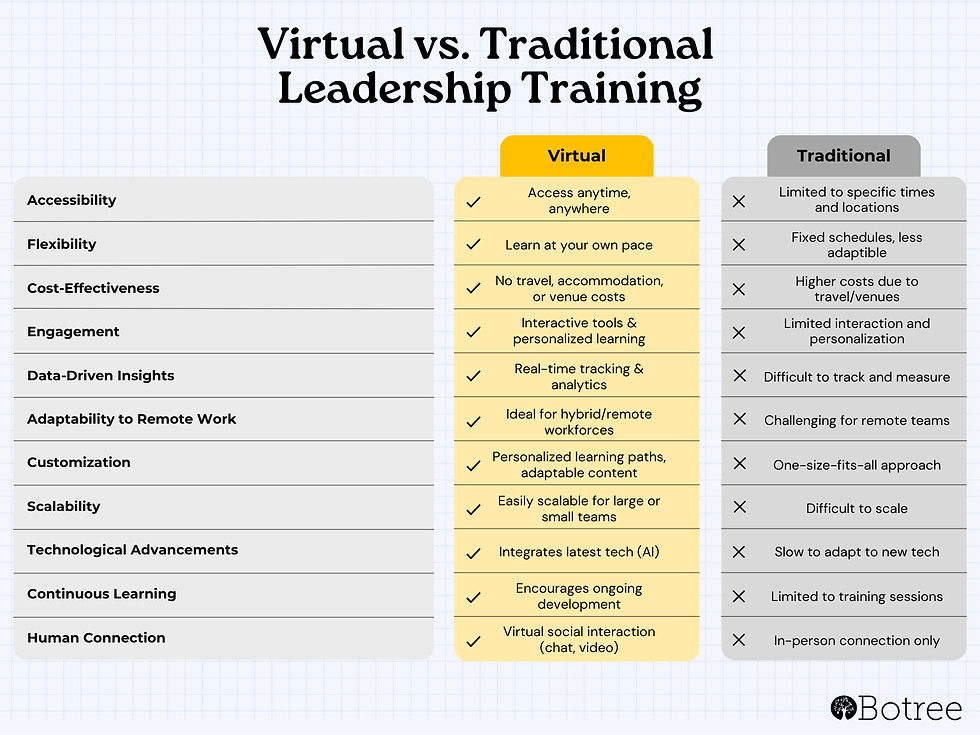⏰ 5 minute read ⏰
That’s the question, isn’t it? Whether it’s workplaces, doctor’s appointments, or training, the debate between virtual and traditional methods is a hot topic right now. Let’s be honest—I'm not here to tell you that one is categorically better than the other. Take online doctor’s appointments, for example. For me, it’s been a game changer: no more sitting in a room full of sick people? Count me in. But my parents? They’re not too thrilled about getting medical advice from a stranger on a screen. Fair point.
The push to digitize everything is strong, especially when it comes to workplace training. And like I said, depending on the context, neither virtual nor traditional in-person training is universally “better.” However, as someone who facilitates and builds virtual training programs, I have my thoughts on why virtual training often comes out on top. So, grab your digital coffee, and let me share my favorite aspects of virtual training.

Don't miss the tip on point #2!
1. Accessibility & flexibility
You know what’s worse than having to carve out time from your busy day for training? Having to take a mandated four-hour chunk out of the most productive part of your day and then driving to a training session. The training programs I build are designed to be accessed anytime, anywhere, allowing you to complete modules when you feel most motivated, prepared, and open to learning.
Of course, there’s a catch—like the possibility that someone might go through an entire nine-week program without touching the material. That’s why we’ve found it’s still essential to include a weekly live touchpoint, just an hour or so to check in and chat with the team.
The key to successful virtual training is what I call “just in time, just enough, just for me” learning. This means making sure your training content is accessible whenever you need it, is concise enough to cover the key points without overwhelming you, and is personalized to be relevant to your role and position. Balancing professional development with daily responsibilities can be tough, but with these strategies, it’s not just possible—it’s attractive.
2. Enhanced engagement
Let me tell you about the time I realised that adults thrive off the same engagement tactics as children. It was during one of the first virtual training sessions I facilitated, where I decided to throw in a live, competitive quiz at the end of the module. I wasn’t sure how it would go over, but to my surprise, the participants lit up like kids at a carnival. Suddenly, the energy in the room—or rather, the virtual room—was buzzing. That’s when it hit me: adults, just like kids, need challenges, engaging visuals, and most importantly, fun!
This is where technology really shines in virtual training. We can tap into so many tools to keep things dynamic and interactive. Whether it’s through live quizzes that foster a bit of friendly competition, visually engaging content that keeps everyone’s attention, or gamified elements that make learning feel less like a chore and more like a game, the possibilities are endless.
But—and here’s a word to the wise—keep track of your subscriptions! The one thing I can’t stand about the digitization of the workplace is how easy it is to get buried under subscription after subscription. You start off with one or two tools, and before you know it, you’re juggling ten different services, each with its own monthly fee. My advice? Set up a tracker for all your subscriptions and build a plan to review them regularly. This way, you can make sure you’re only paying for what’s truly worth your while.
The bottom line is, when done right, technology can transform virtual training from a mundane task into an engaging and even enjoyable experience. By constantly being on the lookout for new technologies—and being smart about managing them—you can keep your training sessions fresh, exciting, and most importantly, effective.
3. Cost-effectiveness
With the majority of employers and employees now equipped with a home or work setup that includes a laptop, camera, and mic, the barrier to entry for virtual learning is practically non-existent. Almost everyone is already set up and ready to go, making it easier than ever to dive into virtual training without the need for additional investments in hardware or technology.
One of the advantages of virtual training is the cost savings it offers. Think about it—no more travel expenses, no need to book accommodations, and no renting out physical venues. These costs can add up quickly, especially when you’re dealing with large teams or multiple locations. By moving to a virtual format, organizations can save a significant amount of money while still delivering top-notch training.
What’s even better is that this cost-effectiveness doesn’t come at the expense of quality. Virtual training is highly scalable, meaning you can roll it out to a broad audience without worrying about breaking the budget. Whether you’re training a small team or an entire organization, you can do so in a way that’s both efficient and affordable. This scalability also opens up the opportunity for continuous learning, allowing employees to access training modules as needed, rather than waiting for the next in-person session.
So there you have it...
While both virtual and traditional training have their place, I’m leaning pretty heavily toward the virtual side of things—and for good reason. With the flexibility to learn anytime, anywhere, the enhanced engagement that technology brings, and the undeniable cost savings, virtual training is a win-win for both organizations and their teams. At the end of the day, it’s about making learning accessible, engaging, and effective, without the hefty price tag. So, why not give it a try? You might just find that virtual training is exactly what your team needs to thrive.

.png)